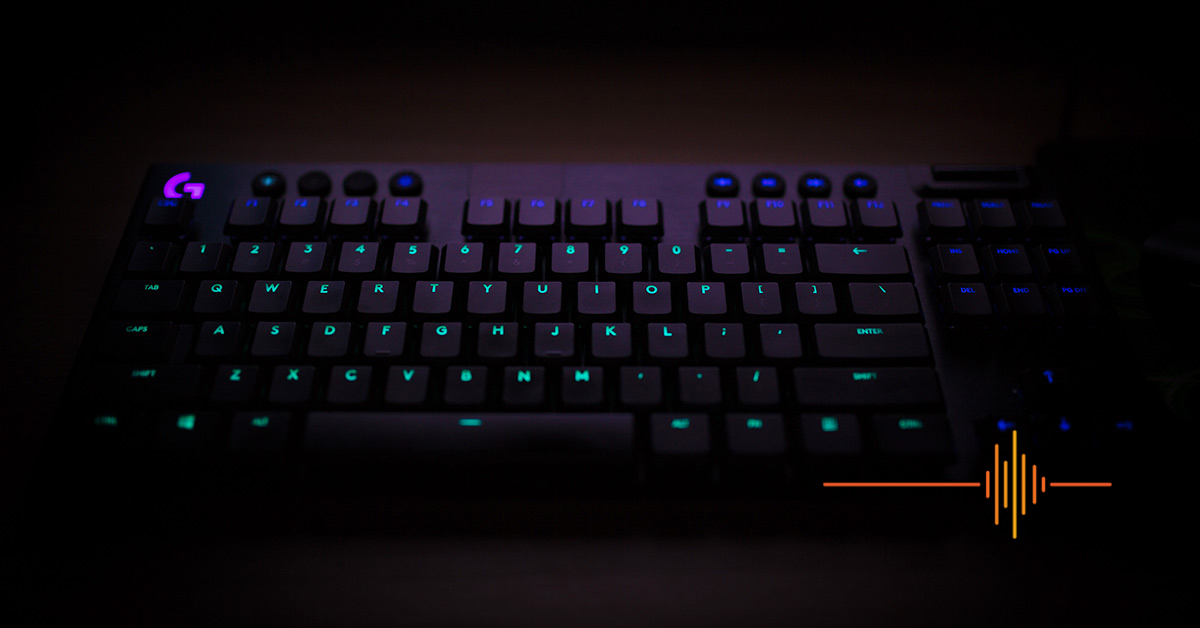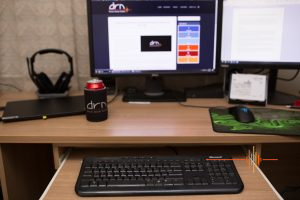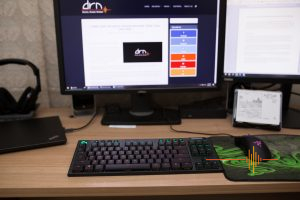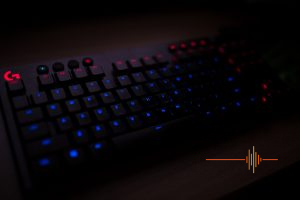 I write this review about and on the Logitech G915 TKL Tenkeyless LIGHTSPEED Wireless RGB Mechanical Gaming Keyboard (GL Linear Edition). For something with such a long name, this compact unit neatly fits on my desk. In fact, it has somewhat revolutionised how I work and my general set up.
I write this review about and on the Logitech G915 TKL Tenkeyless LIGHTSPEED Wireless RGB Mechanical Gaming Keyboard (GL Linear Edition). For something with such a long name, this compact unit neatly fits on my desk. In fact, it has somewhat revolutionised how I work and my general set up.
It feels like the keyboard has always belonged there. Sturdy with a solid weight and feel; littered with brilliant and vibrant RGB behind every key; snappy in response and quieter than I expected; the Logitech G915 TKL may not be for everyone, but let me share why I love the addition to my desk.
First Impressions of the Logitech G915 TKL
Who cares about the box? It was quickly opened and discarded.
First thing I noticed is the weight in my hands. This keyboard is heavy. It actually weighs an impressive 810g. Yes, the keyboard is almost a kilogram in weight. It is heavier than any of my traditional membrane keyboards I have here. But the heavy weight combined with the rubber feet mean this keyboard will not slide around on your desk. It sits still no matter what you throw at it, which is not something I can say for my previous keyboard.
Coming in at 368mm long, 150mm wide, and a mere 22mm high, the Logitech G915 TKL is small in size. When they say it features low profile mechanical gaming switches, they certainly are telling the truth. Lying flat (with the feet tucked up), if I rest my thumb on the desk my thumb is actually fractionally higher than the space bar. With the feet positioned up, it gives a nice gentle slope to the keyboard that I find to be just right.
The face of the keyboard features a cool gun-metal aluminium alloy finish. When I say cool, I don’t mean The Fonz cool. It is ice cold to the touch. Since using it for a while, writing this review, I will add that this does not change even after extended use with the RGB burning bright. The keyboard just remains cool.
In the box came the keyboard (of course), the LIGHTSPEED USB receiver, a USB extender, a micro-USB cable coming in at a very respectable 1.8 metres in length, and the documentation. Following the documentation made installing the keyboard a breeze. Simply plug in with the cable, turn it on, click the wireless button, grab the software (which is used for many Logitech products), and follow the instructions. Simple!
TenKeyLess (TKL) –Wait, what’s that all about?
Okay, let’s address the elephant in the article straight up.
There’s something missing on this keyboard. It is significant, it is strange, it is off-putting, and… well, what do I think?
Tenkeyless, or TKL, is symbolic of the ten numbers (0-9) and numberpad in general that are missing from the far right of the keyboard. When the G915 was offered, which comes in both standard and TKL models, I actually requested the TKL model. And, I’ll be honest: I instantly second-guessed myself after making the request.
Do I have regrets now, though?
Nope!
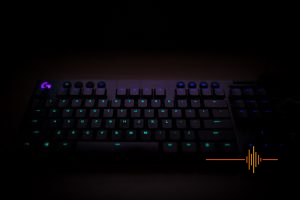 In truth, after about five minutes of me going “But, it is missing the numberpad?!” on Discord to mates, I completely forgot it was missing. The only time I notice it now is when I log into banking and I get a text with a 2FA code that I need to type in.
In truth, after about five minutes of me going “But, it is missing the numberpad?!” on Discord to mates, I completely forgot it was missing. The only time I notice it now is when I log into banking and I get a text with a 2FA code that I need to type in.
Now, if you do a lot of data entry (like I sometimes do at work, but I use a different keyboard for work), you will probably not like the TKL model. But, for me, I generally love it.
Why?
If for no other reason, it makes the keyboard so much more compact and lets it fit where it has to be. On top of that, and this sounds a weird one considering my previous set up (more on that in a second), I much prefer how much closer my hands are when gaming. With the number pad there, it is an extra 2-3 inches between my left hand on WASD and my right hand on my mouse. It all just feels more comfortable.
Going Wireless with the Logitech G915 TKL
Utilising Logitech’s LIGHTSPEED wireless, claimed to be superfast and reliable wireless connectivity with 1ms response rate, the G915 TKL is actually incredibly responsive. While gaming, DOTA 2, Battlefield 3 (that we fired up the other week in memory of a departed clan mate), Apex and Rainbow Six: Siege all play like dreams.
Does the Logitech G915 TKL make me a better player? I want to say yes, but I’m not sure tech can help that much. But I will say that moving around in first person shooters is seamless. Mashing skills out in intense team fights in DOTA2, nothing goes amiss beyond my own incompetence, and the spells flow freely. While before I would often scream that I used a certain skill, or that I had not stepped around the corner in an FPS, I am no longer experiencing those frustrations. I’m not going pro any time soon, especially at my age, but I have seen an improvement and found gaming to be more enjoyable and less frustrating.
Bonus feature: on the rear of the keyboard, there is a little slot where you can slip your LIGHTSPEED USB receiver. Very handy if you’re likely to be transporting the keyboard to gaming LANS or taking it to work.
I will note one problem, but it is one I can replicate and know to expect. And, to be honest, I don’t think it is the keyboard, but most likely my USB controller / motherboard as presently, I am still running an older computer. I have discovered that if I plug in something to my USB 3 port on the front of my computer and start data transfers (e.g. a memory card reader to transfer photos or an external hard drive), the keyboard struggles to maintain wireless connection. The wireless button on top flashes on and off and the keys become sporadically unresponsive. It catypypiingingngn g lilikek thi . [Which translates to “It can result in typing like this.”] Unplug the drive or memory card reader, however, and the keyboard reconnects and goes back to normal! Now, if my mobile phone is plugged in to charge or as a hotspot, there are no issues. It only seems to be during data transfers. As such, I am certain it is more my computer than the keyboard, but thought I would share the experience in case you come across it, too.
Didn’t you say it revolutionised your set up?
Yes, dear reader, I did.
As I said, I predominantly work from home at present, so space is at a premium in my office. Working from home has meant I have an extra laptop, mouse, keyboard and headset in my home office. Between being wireless and the smaller size, the Logitech G915 TKL is so much easier to both use in my workspace but also move around on the desk or room. (My co-workers love my display of tech gear… and whisky… behind me during meetings.) But it is more than that.
Before the Logitech G915 TKL, I was using a wired keyboard for my personal computer that resided in a keyboard drawer and a wireless keyboard sat on my desktop for work. I cannot tell you the number of times that I started typing on my personal keyboard while working and wondered why nothing was happening on screen. It wasn’t an ideal setup.
Combining both the wireless and the smaller size with the TKL, I have changed my set up. After trialling the keyboard on the desktop, I now happily move the keyboard I’m not using to a shelf behind me and work from the main desktop instead.
As a result, I have been able to remove the unsightly 80s style keyboard drawer. This means I can raise my chair and position it closer to the desk, meaning that I am sitting at a better height for my legs and my arms / wrists to be more ergonomically positioned. I am much more comfortable during long gaming and work sessions, and notice a drastic reduction in RSI symptoms that were starting to creep in. It has also saved me kicking my knees on it, which I was doing almost daily, or knocking my wired keyboard off the back of the drawer to the floor.
Keep powering on! Logitech G915 TKL Battery Performance
Battery life is always a concern with wireless devices. The Logitech G915 TKL performs extremely well on this front. Naturally, it comes down to how bright you have the vivid RGB lights blaring, but if you have them at a modest level, you will find the battery life really reasonable. Logitech claim 40 hours with 100% RGB lighting and I would be happy to support this claim.
I’ve not had a stop watch out timing it, but with my lighting down a few notches on the brightness scale, I find I only need to charge my keyboard once a week at most. This is with heavy gaming sessions on weekends, games every night after work, plus working away on this here site.
In terms of alerting you to low battery, the keyboard has a lovely feature where the RGB lights change and either breathe red (i.e. going brighter and fading in a breathing motion), go fixed red, or turn off all together once the battery hits 15%. Plugging the keyboard in to charge while you use it causes no discernible difference in performance, which is further testament to the performance of the wireless. Between the early warning RGB lights and the charge-and-play feature, you will never find yourself mid-game with a flat battery and mashing keys frantically with nothing happening.
I will note, though, that when I tried to charge from a different power source (I often charge devices from the USB ports on my modem / router), it does disable the wireless connection, and thus the keyboard stops working. Always charge from a USB port on your computer, and you will be aces.
Joining the clique of Mechanical Keyboards
I freely admit this is my very first mechanical keyboard.
I love tech, but I am not always quick on the uptake. Despite the offer of joining a sponsored eSports team back in the days of Battlefield 3, I had never taken the step over to the ‘hard core gamer’ sphere of mechanical keyboards. In fact, Kevin was recently disgusted to hear that I was using an old (it may have been well over ten years old…) standard corded Microsoft membrane keyboard that I literally got paid to take (I paid $5 on sale and received a $7 cashback from Microsoft). I was once a poor student.
One of my main hesitations with going mechanical has always been the stereotype associated that they are overly ‘clicky’ – loud, with noticeable tactile sensation typing. While I’m a gamer, I have always been a writer and the idea of that forced feedback and loud clicking emanating through the wee small hours when I often work was a move I did not want to make.
Kevin encouraged me to try something new and give the Logitech G915 TKL mechanical keyboards a workout. And this is a one hell of a detour from both my Microsoft keyboard and my perceptions of what mechanical keyboards were.
Going for the GL Linear keys, this keyboard feels and sounds not too different from my work membrane keyboard, the Logitech MK 295 Wireless. The Logitech G915 TKL is clean to type on, providing a nice crisp click, but nothing loud and overbearing. It doesn’t interrupt my music or people sleeping in the house as I type out some work or bang the keys as I game late into the night.
GL Linear – A smooth transition
The Logitech G915 TKL comes with three variations of mechanical keys. You have the GL Tactile Key type, which has a quite noticeable bump as you press the key down. You have the GL Clicky Key type, which, as the name suggests, goes click! as you press the key down. And you have the GL Linear Key type, which, well, is linear. The key goes down and ‘actions’ the signal without any noticeable feedback to the typer.
Naturally, this all comes down to personal preference. Many players of MMOs prefer Tactile to give feedback that they have pressed the key; people who love FPS shooters like Linear for smooth key presses as they round corners and run across the map; and then there are the “pests” who like Clicky to annoy their workmates while using mechanical keyboards at the office. (No, seriously, don’t ever use a Clicky mechanical keyboard at the office.) Each key type have legions of fans and there is no way for me to tell you which to use.
If you’re lucky, many stores have test key pads, where they have the different key types on a mini-board for you to press and get a feel for each key. Just ask your friendly sales assistant.
The Logitech G915 TKL with GL Linear Low Profile Mechanical Keys
Personally, I went for the GL Linear key. For me, it feels most similar to a traditional membrane keyboard, and sounds not too dissimilar to my Logitech MK295 Silent Wireless membrane keyboard. It is not loud (extremely important so I don’t annoy people at home or for it coming through Discord). Typing on it is smooth and the words seem to flow. It plays extremely well while playing FPS shooters like Rainbow Six: Siege or Apex. For me, it was a perfect choice and a great step into mechanical keyboards.
The only problem? It’s not really a problem. It’s something I used to do on my old keyboard, too. But sometimes I get a case of the zzzzzzzzzzzzzzzzs when I get lazy and rest on a key slightly too much. Since it doesn’t have the feedback of the “discernible bump” or “audible click” of Tactile or Clicky variants, you can find yourself typing without knowing. But, that says more about me than the keyboard!
Get In The RGB Game and Game with Flair
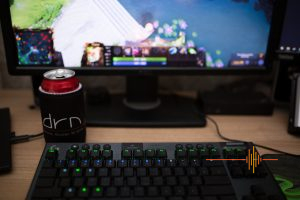 Everything has RGB these days (which is the topic of a whole other conversation). The Logitech G915 TKL doesn’t disappoint, utilising next-gen RGB to synchronize lighting with game profiles. The spiel advertises ~16.8million colours with the ability to create custom animations. And I don’t doubt it.
Everything has RGB these days (which is the topic of a whole other conversation). The Logitech G915 TKL doesn’t disappoint, utilising next-gen RGB to synchronize lighting with game profiles. The spiel advertises ~16.8million colours with the ability to create custom animations. And I don’t doubt it.
Using the Logitech G HUB software, you can customise just about anything. It comes with a whole collection of presets and animations. Turn the lights off completely or have fixed colours; have a wave of colours flowing through the keyboard; echo your key touches where, on a base colour, every key press changes colour and slowly fades over time; have deep blue lights with flashes of white lightning ripping through the keys; or just a simple rotation of colours breathing in and out.
The basics are simple but effective. You can also just paint your keyboard however you like. Set all the keys to one colour, then colour just a few, which could be quite handy for particular games or programs where you only want certain keys highlighted.
The Game Mode options allow you to block certain keys while gaming. Keep hitting the Windows key and minimising to desktop? The keyboard and software allow you to stop that! You can also assign any number of short cuts and macros through the software, which is great, too.
But my favourite feature? The instinctual way the keyboard works with some games. I opened DOTA 2 when I got my keyboard, and my keyboard went red on the menu. That’s odd, I thought. But I started a game. Soon as I was on the map, my keyboard went dark. As I bought each item, the corresponding shortcut key lit up. As I levelled up my hero through the game, the corresponding key to each skill lit up. If I used my skill, the key changed colour for the duration the spell / skill was on cool down. Now, admittedly, I rarely look at my keys while typing or gaming. But it is a funky little feature which I love.
Bonus Controls
Across the top of the keyboard are a few simple control keys.
On the very top edge, you will find the Micro USB charge point and the power switch. The power switch is nice and firm and takes a tiny bit of force to switch, so there’s no chance of bumping your keyboard off if you were sitting something behind your keyboard. The Micro USB charging is something that does my head in a little — why manufacturers aren’t going to USB-C, beyond the obvious cost factor, confuses me. But, when you’re paying a premium price for something like a mechanical keyboard, there is no excuse for not having USB-C. Your latest tech should have the latest tech.
On the main face of the keyboard, above the actual keys, there are eight round rubber buttons. The ones on the left control functions of the keyboard: switching between wireless and Bluetooth, turning on Game Mode, or altering the lighting (both brightness and previewing some different lighting modes by pressing it and numbers).
Two little indicator lights for battery and caps lock are before the standard media control buttons – previous track, play/pause, next track and mute. All four buttons naturally work with all the normal programs; skipping tracks on Spotify is something I generally went to the app for. Not now.
Finally, there’s an inch long scroll wheel at the top of the far right of the keyboard – this smooth wheel acts as volume controller. I don’t use it often except when I’m only listening to music. In game, I stick to my headset to control volume levels. While I like it, my only word of warning is don’t flick it like a mouse scroll wheel — you may go deaf!
Bluetooth Compatibility
One thing I will touch on, though I didn’t use much, is Bluetooth.
My keyboard is connected to my personal computer via the LIGHTSPEED wireless dongle. But I have found it easy to pair this keyboard via Bluetooth with other devices, from my iPhone (meaning I can write lengthy texts or emails on my phone), my TV (which makes searching Netflix much easier) or even my work laptop.
Switching from my PC to the device paired via Bluetooth is as simple as pressing the button on the top of the keyboard, meaning I could easily use the same keyboard and switch between work (connecting to my work laptop via Bluetooth) and play (connecting my gaming computer via wireless) with just the press of a button.
Solid Performance, Superb Battery Life [Conclusion]
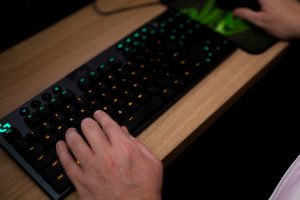 So, having used the keyboard for a couple of months now, do I love it?
So, having used the keyboard for a couple of months now, do I love it?
Honestly, more than a little bit. Bower by name, by nature, but my old keyboard is now in the bin.
The switch to mechanical keyboards has been made so easy with the smooth GL Linear keys that are super responsive; the addition of more RGB has been made great by giving it actual purpose; battery life has been superb and meant no more than half dozen charges in two months of use on my personal computer; and the flexibility the size and being wireless has offered my work space has been truly fantastic in my increased time spent in this home office. I would highly recommend this keyboard to anyone considering a switch to mechanical keyboards.
I’ll just note, too, that the Logitech G915 TKL keyboard comes in the beautiful dark gun-metal grey colour (called Carbon) with black GL Tactile, GL Clicky and GL Linear keys, but also in a light aluminium colour with white GL Tactile keys (only).
Naturally, too, you can find the G915 in Carbon coming with that number pad on the end, but, for me, I think I have become a strong convert of not having the number pad (and that’s with me using a keypad with a number pad every day during work hours).
The Logitech G915 TKL is $379.95 and available at all good stores that sell great tech.
Many thanks to Logitech for introducing me to the wonders of mechanical keyboards and, while throwing me well in the deep end with a TKL, I am well and truly a convert with respect to mechanical, wireless and TKL keyboards.
Specifications of the Logitech G915 TKL
Physical
- Length: 368 mm
- Width: 150 mm
- Height: 22 mm
- Weight (w/o cable): 810 g
- Cable Length: 1.8 m
Key Options
Low Profile GL Tactile Key Switches:
- Feedback type: Discernible Bump
- Actuation distance: 1.5 mm
- Total travel distance: 2.7 mm
- Average force: 50 gf
- Tactile Force: 60gf
Low Profile GL Linear Key Switches:
- Feedback type: Smooth
- Actuation distance: 1.5 mm
- Total travel distance: 2.7 mm
- Average force: 50gf
- Tactile Force: N/A
Low Profile GL Clicky Key Switches:
- Feedback Type: Audible Click
- Actuation distance: 1.5 mm
- Total travel distance: 2.7 mm
- Average force: 50 gf
- Tactile Force: 60gf
Battery Life:
- 40 hours (100% brightness)
Onboard Memory:
- 2 Lighting Profiles
- 3 Macro Profiles
Other Features:
- LIGHTSPEED Wireless
- Bluetooth
- LIGHTSYNC RGB, per key lighting
- Dedicated media control and edgeless volume wheel
Requirements
- LIGHTSPEED Wireless: USB port and Windows7® or later, macOS X 10.11 or later
- Bluetooth: Bluetooth enabled device with Windows 8 or later, macOS X 10.11 or later, Chrome OS™, or Android™ 4.3 or later, iOS 10 or later
- (Optional) Internet access and Windows 7 or later (64-bit) or macOS X 10.11 or later for Logitech G HUB software4Advanced features require Logitech G HUB Gaming Software, available for download at logitechg.com/GHUB
Warranty
- 2-Year Limited Hardware Warranty


